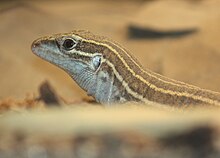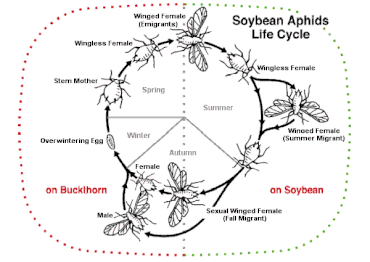Asexual reproduction

Asexual reproduction is a type of
While all
Types of asexual reproduction
Fission
Multiple fission at the cellular level occurs in many
In
Budding

Some cells divide by budding (for example baker's yeast), resulting in a "mother" and a "daughter" cell that is initially smaller than the parent. Budding is also known on a multicellular level; an animal example is the hydra,[10] which reproduces by budding. The buds grow into fully matured individuals which eventually break away from the parent organism.
Internal budding is a process of asexual reproduction, favoured by parasites such as Toxoplasma gondii. It involves an unusual process in which two (endodyogeny) or more (endopolygeny) daughter cells are produced inside a mother cell, which is then consumed by the offspring prior to their separation.[11]
Also, budding (external or internal) occurs in some worms like
Vegetative propagation
Spore formation
Many multicellular organisms produce
Fungi and some algae can also utilize true asexual spore formation, which involves mitosis giving rise to reproductive cells called mitospores that develop into a new organism after dispersal. This method of reproduction is found for example in conidial fungi and the red algae Polysiphonia, and involves sporogenesis without meiosis. Thus the chromosome number of the spore cell is the same as that of the parent producing the spores. However, mitotic sporogenesis is an exception and most spores, such as those of plants and many algae, are produced by meiosis.[14][15][16]
Fragmentation

Fragmentation is a form of asexual reproduction where a new organism grows from a fragment of the parent. Each fragment develops into a mature, fully grown individual. Fragmentation is seen in many organisms. Animals that reproduce asexually include
Clonal Fragmentation in multicellular or colonial organisms is a form of asexual reproduction or cloning where an organism is split into fragments. Each of these fragments develop into mature, fully grown individuals that are clones of the original organism. In echinoderms, this method of reproduction is usually known as fissiparity.[19] Due to many environmental and epigenetic differences, clones originating from the same ancestor might actually be genetically and epigenetically different.[20]
Agamogenesis
Agamogenesis is any form of reproduction that does not involve a male gamete. Examples are parthenogenesis and apomixis.
Parthenogenesis
Parthenogenesis is a form of
Facultative parthenogenesis

In facultative parthenogenesis, females can reproduce both sexually and asexually.[21] Because of the many advantages of sexual reproduction, most facultative parthenotes only reproduce asexually when forced to. This typically occurs in instances when finding a mate becomes difficult. For example, female zebra sharks will reproduce asexually if they are unable to find a mate in their ocean habitats.[2]
Parthenogenesis was previously believed to rarely occur in vertebrates, and only be possible in very small animals. However, it has been discovered in many more species in recent years. Today, the largest species that has been documented reproducing parthenogenically is the Komodo dragon at 10 feet long and over 300 pounds.[25][26]

Heterogony is a form of facultative parthenogenesis where females alternate between sexual and asexual reproduction at regular intervals (see Alternation between sexual and asexual reproduction). Aphids are one group of organism that engages in this type of reproduction. They use asexual reproduction to reproduce quickly and create winged offspring that can colonize new plants and reproduce sexually in the fall to lay eggs for the next season.[27] However, some aphid species are obligate parthenotes.[28]
Obligate parthenogenesis

In obligate parthenogenesis, females only reproduce asexually.[21] One example of this is the desert grassland whiptail lizard, a hybrid of two other species. Typically hybrids are infertile but through parthenogenesis this species has been able to develop stable populations.[29]
Gynogenesis is a form of obligate parthenogenesis where a sperm cell is used to initiate reproduction. However, the sperm's genes never get incorporated into the egg cell. The best known example of this is the Amazon molly. Because they are obligate parthenotes, there are no males in their species so they depend on males from a closely related species (the Sailfin molly) for sperm.[30]
Apomixis and nucellar embryony
Apomixis in plants is the formation of a new
Alternation between sexual and asexual reproduction

Some species can alternate between sexual and asexual strategies, an ability known as heterogamy, depending on many conditions. Alternation is observed in several rotifer species (cyclical parthenogenesis e.g. in Brachionus species) and a few types of insects.
One example of this is aphids which can engage in heterogony. In this system, females are born pregnant and produce only female offspring. This cycle allows them to reproduce very quickly. However, most species reproduce sexually once a year. This switch is triggered by environmental changes in the fall and causes females to develop eggs instead of embryos. This dynamic reproductive cycle allows them to produce specialized offspring with polyphenism, a type of polymorphism where different phenotypes have evolved to carry out specific tasks.[27]
The cape bee
The slime mold Dictyostelium undergoes binary fission (mitosis) as single-celled amoebae under favorable conditions. However, when conditions turn unfavorable, the cells aggregate and follow one of two different developmental pathways, depending on conditions. In the social pathway, they form a multi-cellular slug which then forms a fruiting body with asexually generated spores. In the sexual pathway, two cells fuse to form a giant cell that develops into a large cyst. When this macrocyst germinates, it releases hundreds of amoebic cells that are the product of meiotic recombination between the original two cells.[34]
The hyphae of the common mold (Rhizopus) are capable of producing both mitotic as well as meiotic spores. Many algae similarly switch between sexual and asexual reproduction.[35] A number of plants use both sexual and asexual means to produce new plants, some species alter their primary modes of reproduction from sexual to asexual under varying environmental conditions.[36]
Inheritance in asexual species
In the rotifer Brachionus calyciflorus asexual reproduction (obligate parthenogenesis) can be inherited by a recessive allele, which leads to loss of sexual reproduction in homozygous offspring.[37][38]
Inheritance of asexual reproduction by a single recessive locus has also been found in the parasitoid wasp Lysiphlebus fabarum.[39]
Examples in animals
Asexual reproduction is found in nearly half of the animal phyla.[40] Parthenogenesis occurs in the hammerhead shark[41] and the blacktip shark.[42] In both cases, the sharks had reached sexual maturity in captivity in the absence of males, and in both cases the offspring were shown to be genetically identical to the mothers. The New Mexico whiptail is another example.
Some reptiles use the ZW sex-determination system, which produces either males (with ZZ sex chromosomes) or females (with ZW or WW sex chromosomes). Until 2010, it was thought that the ZW chromosome system used by reptiles was incapable of producing viable WW offspring, but a (ZW) female boa constrictor was discovered to have produced viable female offspring with WW chromosomes.[43] The female boa could have chosen any number of male partners (and had successfully in the past) but on this occasion she reproduced asexually, creating 22 female babies with WW sex-chromosomes.
Bdelloid rotifers reproduce exclusively asexually, and all individuals in the class Bdelloidea are females. Asexuality evolved in these animals millions of years ago and has persisted since. There is evidence to suggest that asexual reproduction has allowed the animals to evolve new proteins through the Meselson effect that have allowed them to survive better in periods of dehydration.[44] Bdelloid rotifers are extraordinarily resistant to damage from ionizing radiation due to the same DNA-preserving adaptations used to survive dormancy.[45] These adaptations include an extremely efficient mechanism for repairing DNA double-strand breaks.[46] This repair mechanism was studied in two Bdelloidea species, Adineta vaga,[46] and Philodina roseola.[47] and appears to involve mitotic recombination between homologous DNA regions within each species.
Molecular evidence strongly suggests that several species of the
In the grass thrips genus Aptinothrips there have been several transitions to asexuality, likely due to different causes.[50]
Adaptive significance of asexual reproduction
A complete lack of sexual reproduction is relatively rare among multicellular organisms, particularly animals. It is not entirely understood why the ability to reproduce sexually is so common among them. Current hypotheses[51] suggest that asexual reproduction may have short term benefits when rapid population growth is important or in stable environments, while sexual reproduction offers a net advantage by allowing more rapid generation of genetic diversity, allowing adaptation to changing environments. Developmental constraints[52] may underlie why few animals have relinquished sexual reproduction completely in their life-cycles. Almost all asexual modes of reproduction maintain meiosis either in a modified form or as an alternative pathway.[53] Facultatively apomictic plants increase frequencies of sexuality relative to apomixis after abiotic stress.[53] Another constraint on switching from sexual to asexual reproduction would be the concomitant loss of meiosis and the protective recombinational repair of DNA damage afforded as one function of meiosis.[54][55]
See also
- Alternation of generations
- Self-fertilization
- Bacterial conjugation
- Biological life cycle
- Biological reproduction, also simply reproduction
- Cloning
- Hermaphrodite
- Plant reproduction
- Sex
References
- PMID 28381586. Retrieved 21 August 2018.
- ^ PMID 28091617.
- PMID 16950097.
- ^ Jeanna Bryner (20 December 2006). "Female Komodo Dragon Has Virgin Births". livescience.com. Retrieved 18 December 2022.
- ^ "Cell reproduction". Encyclopædia Britannica.
- ISBN 978-1-61530-463-9.
- ISBN 978-81-7625-791-6.
- ISBN 978-0-86720-081-2.
- ISBN 978-0-12-683255-6.
- S2CID 186209549.
- ISBN 978-0-521-42811-8.
- ^ "Asexual Reproduction". Ucmp.berkeley.edu. Retrieved 13 August 2010.
- ^ "Celebrating Wildflowers – Fading Gold – How Aspens Grow". Fs.fed.us. 11 May 2010. Archived from the original on 23 September 2010.
- ^ "Plant." Britannica Academic, Encyclopædia Britannica, 15 Jun. 2021. Accessed 20 Jan. 2022.
- ^ Card, V. (2016). Algae. In M. S. Hill (Ed.), Biology (2nd ed., Vol. 1, pp. 21–23). Macmillan Reference USA.
- ^ "Fungus." Britannica Academic, Encyclopædia Britannica, 4 Oct. 2018. Accessed 20 Jan. 2022.
- ISBN 978-0-03-025982-1.
- ISBN 978-0-03-025982-1.
- ISBN 978-90-481-2766-5.
- PMID 27565761.
- ^ a b c "parthenogenesis | Definition, Types, & Facts". Encyclopedia Britannica. Retrieved 3 December 2020.
- S2CID 4353479.
- PMID 29559496.
- ISBN 978-0-12-381466-1, retrieved 12 December 2020
- ^ Yam, Philip. "Strange but True: Komodo Dragons Show that "Virgin Births" Are Possible". Scientific American. Retrieved 13 December 2020.
- ^ "Komodo dragon". Animals. 10 September 2010. Archived from the original on 17 October 2016. Retrieved 13 December 2020.
- ^ PMID 18579086.
- PMID 22990313.
- PMID 16592761.
- PMID 17148156.
- ^ "Apomixis | reproduction | Britannica". www.britannica.com. Retrieved 23 March 2023.
- S2CID 254022638.
- ^ Lotsy, Johannes Paulus; botanistes, Association internationale des (1907). Progressus rei botanicae = Fortschritte der Botanik = Progrès de la botanique = Progress of botany. Vol. 2. Jena: G. Fischer.
- ISBN 978-81-224-0089-2.
- ISBN 978-0-521-34301-5.
- ISBN 978-0-12-088386-8.
- PMID 20862222.
- PMID 21576287.
- S2CID 1438839.
- )
- ^ Savage, Juliet Eilperin (23 May 2007). "Female Sharks Can Reproduce Alone, Researchers Find". The Washington Post.
- .
- ^ "Boa constrictor produces fatherless babies". CBC News – Technology & Science. 3 November 2010. Retrieved 20 October 2014.
- PMID 17932297.
- PMID 18362355.
- ^ (PDF) from the original on 9 October 2022.
- PMID 18362354.
- (PDF) from the original on 9 October 2022.
- OCLC 1312207506.)
{{cite book}}: CS1 maint: multiple names: authors list (link - S2CID 14853526.
- .
- S2CID 5357709.
- ^ PMID 23995700.
- PMID 3324702.
- ISBN 978-0195369670
Further reading
- Avise, J. (2008). Clonality: The Genetics, Ecology, and Evolution of Sexual Abstinence in Vertebrate Animals. Oxford University Press. ISBN 978-0-19-536967-0.
- Graham, L.; Graham, J.; Wilcox, L. (2003). Plant Biology. Upper Saddle River, NJ: Pearson Education. pp. 258–259. ISBN 978-0-13-030371-4.
- Raven, P. H.; Evert, R. F.; Eichhorn, S. E. (2005). Biology of Plants (7th ed.). NY: W.H. Freeman and Company. ISBN 978-0-7167-6284-3.
